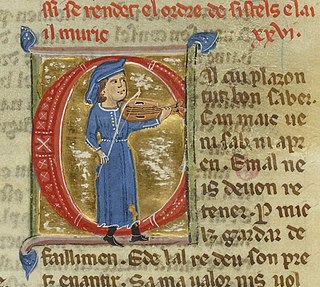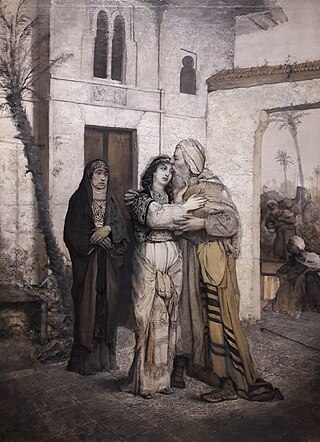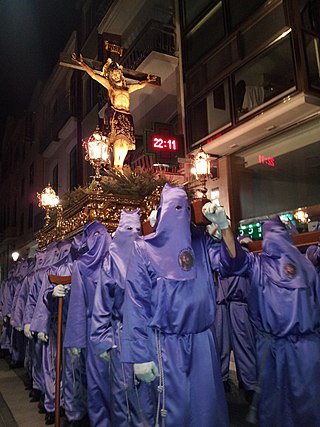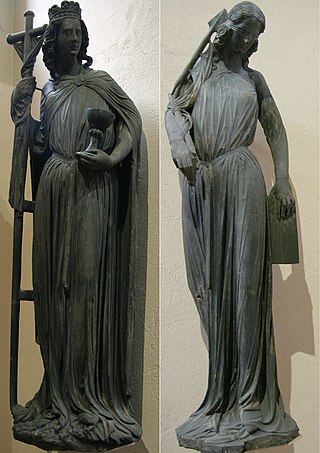
A troubadour was a composer and performer of Old Occitan lyric poetry during the High Middle Ages (1100–1350). Since the word troubadour is etymologically masculine, a female troubadour is usually called a trobairitz.

Nathan the Wise is a play by Gotthold Ephraim Lessing from 1779. It is a fervent plea for religious tolerance. It was never performed during Lessing's lifetime and was first performed in 1783 at the Döbbelinsches Theater in Berlin.

In Christianity, Holy Wednesday commemorates the Bargain of Judas as a clandestine spy among the disciples. It is also called Spy Wednesday, or Good Wednesday, and Great and Holy Wednesday.

The Parable of the Ten Virgins, also known as the Parable of the Wise and Foolish Virgins or the Parable of the ten bridesmaids, is one of the parables of Jesus. According to Matthew 25:1–13, ten virgins await a bridegroom; five have brought enough oil for their lamps for the wait, while the oil of the other five runs out. The five virgins who are prepared for the bridegroom's arrival are rewarded, while the five who went to buy further oil miss the bridegroom's arrival and are disowned.
Liturgical drama refers to medieval forms of dramatic performance that use stories from the Bible or Christian hagiography.
Ordo Virtutum is an allegorical morality play, or sacred music drama, by Hildegard of Bingen, composed c. 1151, during the construction and relocation of her Abbey at Rupertsberg. It is the earliest morality play by more than a century, and the only medieval musical drama to survive with an attribution for both text and music.
The Latin question Quem quaeritis? refers to four lines of the medieval Easter liturgy that later formed the kernel of the large body of medieval liturgical drama, which is also known as Visitatio sepulchri. It was introduced into the liturgy in the tenth century, as a new genre of liturgical ceremony:

The bride of Christ or the lamb's wife is a metaphor used in reference to a group of related verses in the Christian Bible, specifically the New Testament – in the Gospels, the Book of Revelation, the Epistles, with related verses in the Old Testament.

The Ordo Rachelis, Interfectio Puerorum, or Ludus Innocentium is a medieval dramatic tradition consisting in four plays and based on the Massacre of the Innocents, an event recorded in the Gospel of Matthew, and on the prophecy recorded in the Book of Jeremiah: "A voice was heard in Ramah, lamentation, and bitter weeping; Rahel weeping for her children refused to be comforted for her children, because they were not". The prophecy, which Matthew believed to be fulfilled when Herod the Great ordered the slaughter of all boys under two in Bethlehem, looks backwards to Rachel, the matriarch of the Hebrews, and towards her lamentation over the death of her children, the Hebrew children, in the massacre.
The Harrowing of Hell is an eighth-century Latin work in fifty-five lines found in the Anglo-Saxon Book of Cerne. It is probably a Northumbrian work, written in prose and verse, where the former serves either as a set of stage directions for a dramatic portrayal or as a series of narrations for explaining the poetry.
The Verses pascales de tres Maries are twelfth-century Latin lyric verses from Vic that form a liturgical drama for performance at Easter. The play, by an anonymous cleric, is highly original in content and form, though it only runs ninety-four lines.
The Versus de pelegrino or Verses about the Stranger is a medieval Latin drama composed by an anonymous playwright of Vic c. 1130. The Versus is a short piece of only forty lines on the meeting between Mary Magdalene and the glorified Jesus Christ on the road as recorded in the Gospel of John. It is a follow-up to the Verses pascales de tres Maries and was probably designed as a liturgical drama for Easter Vigil as well.

Drama is the specific mode of fiction represented in performance: a play, opera, mime, ballet, etc., performed in a theatre, or on radio or television. Considered as a genre of poetry in general, the dramatic mode has been contrasted with the epic and the lyrical modes ever since Aristotle's Poetics —the earliest work of dramatic theory.
Naheere, commonly known as "Entrance to Heaven", is a practice in the Syriac Orthodox Church which includes a church sermon. It is celebrated on the eve of Monday during Holy Week. The word 'Naheere" is Syriac for light; the idea behind the practice is that, if one asks Jesus into one's heart, Jesus comes in and shows one the light, and one is accepted by his grace into heaven.

Ecclesia and Synagoga, or Ecclesia et Synagoga in Latin, meaning "Church and Synagogue", are a pair of figures personifying the Church and the Jewish synagogue, that is to say Judaism, found in medieval Christian art. They often appear sculpted as large figures on either side of a church portal, as in the most famous examples, those at Strasbourg Cathedral. They may also be found standing on either side of the cross in scenes of the Crucifixion, especially in Romanesque art, and less frequently in a variety of other contexts.
Foebus abierat is a medieval Latin poem, authorship unknown, composed near the end of the 10th century in Northern Italy. Described as "hauntingly beautiful" and "one of the joys of medieval poetry," it is an erotic dream-vision lyric spoken by a woman who grieves the departure of her lover Phoebus, brother of the Moon. Although the language is ecclesiastical Latin, none of its content is explicitly Christian.

The Southern apse from Pedret is a Romanesque fresco painting from late 11th century or the beginning of the 12th century, which was acquired during the 1919-1923 campaign of the Junta de Museus. The artwork originated from the southern apsidiole of the Church of Sant Quirze de Pedret and is currently exhibited in the Romanesque Art collection at the Museu Nacional d'Art de Catalunya, in Barcelona, Spain.
Hry o Marii is a Czech-language opera cycle in four parts, by Bohuslav Martinů. The first performance was on 23 February 1935 at the National Theatre in Brno, with Antonín Balatka conducting, and stage direction by Rudolf Walter. It has been described as "a work of great originality, unlike any other opera" and "imbued with a strange mysticism".

Woman as a Wise Virgin is a circa 1510 oil on canvas painting by Sebastiano del Piombo, now in the National Gallery of Art in Washington.